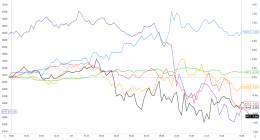Google Analytics 4, more commonly referred to as GA4 is Google’s replacement for Universal Analytics. UA will be sunset in July of next year, after which it will stop collecting data.
Like it or not, GA4 will soon be our only option for collecting user data – but why shut down Universal Analytics in the first place?
Why Is Google Forcing Us to Upgrade to GA4?
Over the last few years, people have become increasingly aware of their data and what companies have been doing with it.
Though legislation has been put in place, such as General Data Protection Regulation (GDPR), people are still concerned with their data and how it’s being used – the rise in VPN services advertising private, untrackable browsing attests to this anxiety.
Google has announced that next year it too will remove third-party cookies, as Firefox and Safari have already done. This means that over 80% of browser traffic will not involve third-party cookies, and UA will be unable to accurately track them.
Google won’t create identifiers to follow people while they browse the internet.
GA4 has been designed to work without using any cookies. In fact, GA4 can use machine learning to make up for any possible data loss. During a 6-day trial in 2021, GA4 was able to retrieve 70% of user journeys. Its accuracy will improve as Google works to enhance GA4.
These third-party cookie changes will have an enormous impact on how advertising will operate in the future – the ability to remarket to site visitors is expected to change significantly.
How Does GA4 Differ From Universal Analytics?
Though there are a ton of differences between UA and GA4, the biggest disparity in using GA4 and its functionality is its event tracking.
Anyone who has used UA is familiar with tracking visitor sessions. A session starts when a visitor enters your site and will end if they leave the site, the session lapses after 30 minutes, or if the time passes midnight. A new session will begin if the visitor resumes activity after 30 minutes if they return through a different campaign.
As GA4 uses events rather than sessions then a page view event will fire every time someone visits regardless of time frames or time between sessions.
During a session, your user may click on certain buttons, access different pages, fill out forms, etc. These are events and up to 30 of these can be turned into conversions which are the replacement for goals that UA uses.
Without session tracking, many of the out-of-the-box reports available in UA will not be present in GA4. To replace these standard reports, GA4 allows you to create customized reports instead. By using Explorations, for example, you can create a sales funnel or session based on events which you can then use to compare journeys across different users.
This change makes setting up events and audiences extremely important as these will be used to build a picture of how visitors use the site and what the issues may be in driving conversions.
For example, an e-commerce site would need to use multiple events like ‘session_start’, ‘view_produc’t, ‘add_to_cart’, and ‘purchase’ to build a full picture. Out of these events, ‘purchase’ may be the only one that is tracked as a conversion.
This new setup will mean a GA4 account will have many more events than a UA account would need.
Finally, it’s worth bearing in mind that GA4 only allows one property per site. This means that should you set up your account incorrectly you’ll be unable to open a new property to start afresh. Therefore, it’s vital to set up your test property and have it running perfectly before transferring to your live property.
What Distinction Is Doing to Ensure Their Clients Experience a Smooth Transition to GA4
Well before July 2022, Distinction set up test accounts for all their clients to give them a chance to get acquainted with GA4 and the features available to them. It means their clients have a full year of historical UA data for a year-on-year comparison before UA is switched off on 1 July 2023.
They are working with their clients to create and implement a measurement strategy that will mean the transition to GA4 will be as smooth as possible and set them up for successful and accurate data capture in the future.
Some of their clients will be launching new sites just after the move to GA4. So Distinction is accommodating this by creating an initial GA4 account which will gather some data but have minimal features so that they can invest time into perfecting their new website’s property once the site is live.
Your GA4 checklist
July 2023 may seem like some way off, but organizations need to act now or run the risk of losing year-on-year data comparisons which are key to identifying market trends, as well as giving you better context on how your website is performing relative to past performance. By taking the steps below, you’ll mitigate this risk as much as possible.
Set up a GA4 test account as soon as possible
It may seem like you’ve got plenty of time to prepare for the switch, but GA4 takes time and effort to set up properly. Set up a test account now and get used to the new interface. Work with events to be absolutely certain that everything is working as expected before transferring to a live account.
Remember, GA4 only allows one property per site, you cannot afford to rush this setup or to have errors in your live account since they will affect your already-limited data.
Create a Measurement Strategy
You need to consider how you will track your visitors through events. The events you choose can map vastly different user journeys and need to be tailored toward your business’s needs. You will also need to set up any custom reports.
Get Your GA4 Account Running Alongside UA
Currently, the only way to transfer your UA data to GA4 would be to get a paid account with Analytics 360 which, depending on the size of your site, could cost upwards of £100,000 GBP.
To ensure a smooth transition without paying to transfer your UA data you should aim to set up GA4 as soon as possible and have it running alongside UA. When UA is the sunset you’ll at least have a year’s worth of data to start with.
Check that Your Current Tracking Integrates with GA4
Ask your other tracking providers how they are adapting to GA4. Be wary of those who try to shrug the question off, you wouldn’t want to be left with reduced tracking.
Test, test, test, and review
Test your GA4 setup and have it running perfectly before moving it to a live property. Remember that you will only have one property for your site and one chance to get this transition right, so don’t move until you have tested everything and are certain that this is the setup you’d like to live with for the foreseeable future.
Export Your UA Data
Though Google has not said outright that they will be removing UA data, there are hints that they will not store your data forever.
They recommend downloading your UA data within six months of the change-over.








